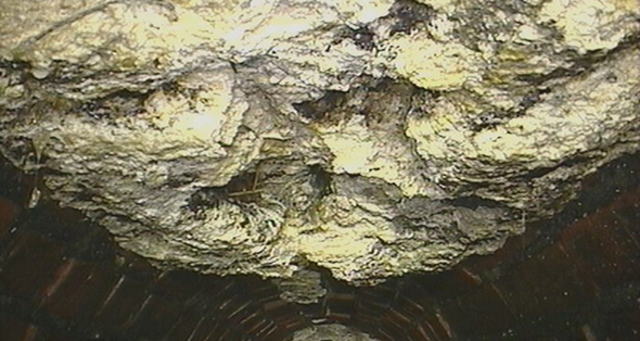London water authority Thames Water has discovered what it calls the UK's largest "fatberg;" a mushy deposit of congealed fat and sanitary wipes. Found in a sewer in Kingston, South West London, the fatberg was roughly the size of a bus, and weighed 15 tons. "We've never seen a single, congealed lump of lard this big clogging our sewers before," says Gordon Hallwood, supervisor at Thames Water. The blockage was discovered after local residents reported being unable to flush their toilets.
The horrific deposit was so large that it's taken the sewer in question out of action. Before it was removed, it had reduced the sewer's capacity to just five percent of its regular level, and the damage it caused will take six weeks to repair. "If we hadn't discovered it in time, raw sewage could have started spurting out of manholes across the whole of Kingston." Thames Water has been pleading with Londoners to not dispose of fat and wipes through their drains. It removes tons of fat from London sewers every month at a great cost to customers, and has recently started using the fat to generate electricity.
But there is a silver lining forming....
Burn it with fire! Well, use it as an alternative energy source.
Fat and oil that accumulate in the city's drains and sewers -- forming large clogging masses called "fatbergs" -- are to be harvested and used to generate electricity at the largest plant of its kind in the world.
The grease will be fed into a power station at Beckton in east London that will produce an estimated 130 gigawatt hours (GWh) a year of renewable electricity, according to BBC News. An operation of that scale would be unprecedented.
London waterworks Thames Water has a crew of about 40 "sewer flushers" that patrol London's largest trunk sewers and clear 80,000 blockages a year. Check out the mess in the video below.
Most of them are caused by cooking oil and grease, which cool and congeal in the waterways, forming fatbergs (some of the most unusual items the flushers find down below: hand grenades, crayfish, and false teeth). Removing the fatbergs costs more than $1.5 million every month.
The utility plans to install "fat traps" under the sinks of restaurants and fast food outlets in the city. The harvested fat, as well as fat in the sewers, will be burned at the east London plant starting in 2015.
The company running the plant, 20C, says there will be no smoke and no smell from using the fat. Meanwhile, Thames Water will buy 75 GWh of the energy generated to power its Beckton sewage works.
"There's no reason why all these big cities around the world -- New York, Los Angeles, you name it -- shouldn't have these kind of programs going on in their neighborhoods as well," PRI quoted Simon Evans, a spokesman with Thames Water, as saying.


No comments:
Post a Comment